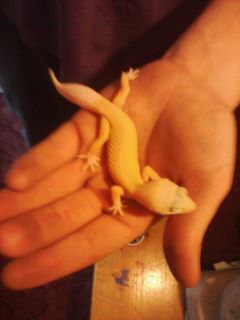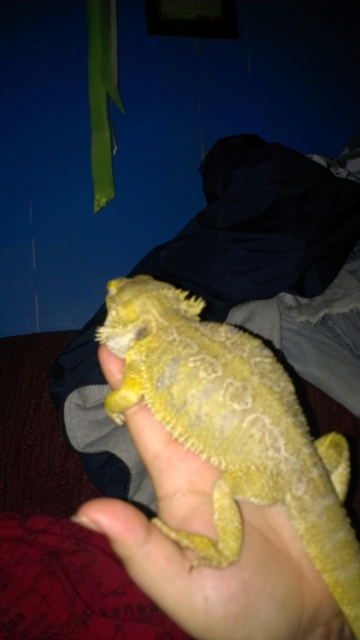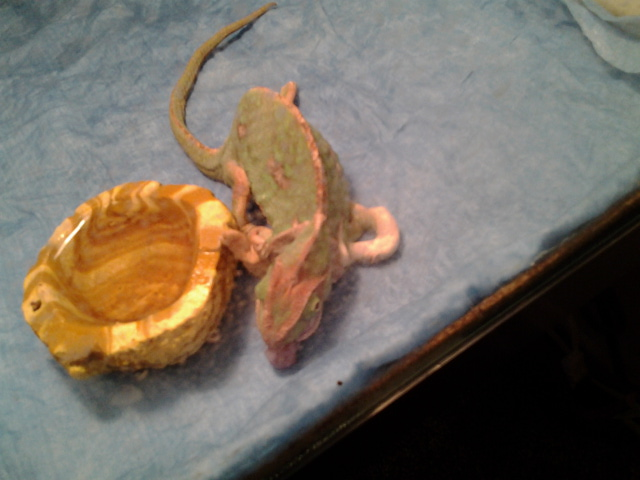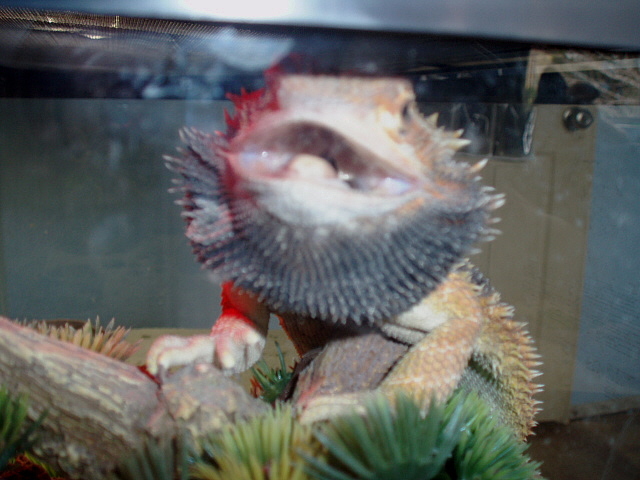QuestionQUESTION: My youngest gecko was seperated for a long while but I wanted her to have some contact so I put her in with another of my small geckos and unfortunately the male she was in with with died of anoerexia. Due to my shift works and college I couldn't get to a vet for a PM so I don't know why he died but he did have one loose stool towards the end and was sick once as well. I think this was more from feeding waxworms and catfood in an attempt to put the weight back on as previous to that there had been no problems; it really was sudden; but I never managed to rule parasites out. In the last few hours of his life I removed her from the viv and put her in with my 4 older geckos. Roughly 48 hours later I noticed there was something that looks like a scab on her head. I seperated her and kept a close eye on her.
Now it's not gotten any better or worse but one of my other geckos had a scratch on his head the other day and now it looks the same. I just want to know if it IS a scab or anything more sinister so I can give the best care possible until the vet has an appointment.
http://i37.photobucket.com/albums/e82/Dracyia/Nokia538.jpg
http://i37.photobucket.com/albums/e82/Dracyia/Nokia544.jpg
Thank-you, Gwen.
ANSWER: Hi Gwen,
Pretty marked Leo!!
Waxworms and the cat food may have caused fatty liver disease.
The vet will be able to use a uv light to determine if it is something such as fungus or just a scab from a scratch. Reptiles do take forever to heal. With it being 48 hrs, you may have missed the initial scratch and only caught the scabbing over part. If you are using sand in the tank, are you sure you aren't seeing sand stuck to a wound?
Have you tried applying some neosporin ointment to the area?
If you were unable to rule out parasites in the one you lost, I do suggest a fecal being done on ALL your remaining geckos as you have them all together now.
If the tank is not large enough for 5 leos, there most likely has been and will be some fights for "space", plus she was put into their territory. For that many leos together, I would not use anything smaller than a 75 gallon tank.
BASIC CARE FOR A LEOPARD GECKO
Leopards are pretty easy to care for but they do need
special care. Here are some of the basic needs of your gecko.
HOUSING: The need to have at least a 20 gallon long tank for one Leo. This needs to have a secure fitting screen top...they can be quite the escape artists!!! They need to have a humid hide box.You can make this with something as simple as a small plastic dish with a hole cut in one side and a small mesh bag filled with some Sphagnum moss coconut bark or Peat moss that you mist.
I made mine out of the small plastic folgers coffee containers...I cut an opening in the lid..and put the moss in..they LOVE it. I use the terrarium moss in mine.
I use that on the warm side of the tank. Be sure to provide a cool hidebox on the other end. I also provide a mid temperature hide...which is in the middle of the tank.I use the critter caves which you can purchase. NOT the ones that have heat in them!!!!
Provide secure climbing areas for your gecko. Fake plants, rocks and branches are all fine to use. be sure there are no wires or sharp ends to any fake plants you use.
*****SUBSTRATE:(that's the stuff on the floor of your tank) Newspaper, lizard carpet or paper towels work great and are easy to clean and are much safer than any loose substrate. Sand or other loose substrate is not recommended as that they can be deadly to the leo when it is ingested(eaten, even by accident while eating their insects)...A very graphic site of an impacted leo surg can be seen at http://homepage.mac.com/exoticdvm/reptile/PhotoAlbum181.html it is very graphic!!! ******What I have found that works great for safety and heat distribution is using about 1/4 inch of childrens play sand(since the tiles fit tight together, there is no sand danger) on the bottom of the tank and on top that you place ceramic or slate floor tile. What is nice is that the 12 x 12 squares fit perfect in a 20 gallon tank with no spaces between the tiles. The sand and the tile distribute the heat wonderfully. Using the under tank heater as described is what distributes the heat. Also, overhead heat will help in heating the tiles...I've been using this set up for several years and the leos love it. Using a tile that isn't smooth is recommended. **********
TEMPERATURES: They need a warm area of 88-92 degrees and a
cooler area in the upper 70s, low 80s. At night their temperature can drop to the low to mid 70's.
Never use a hot rock for a leopard gecko...or any reptile.
They can severely burn any reptile. You can use a heating
pad under the tank,under tank heater, or you can use a regular household lightbulb in a dome fixture with a ceramic socket in it to keep the warm area at the 88-92 degree area.At night, no white light. If room temperatures stay above 70 degrees, no extra night heat is needed. The undertank heater or heating pad should cover about 1/3 of the tank....be sure to raise the tank up about 1/4-1/2 inch off the stand when using an undertank heat source to prevent heat build up which can cause the glass to break and hot spots in the glass. Be sure to have a good layer of newspaper, carpeting or, even a thin flat rock(such as tile) on top the area that the undertank heat source is placed...if you use a thin rock or tile, it helps to distribute the heat very well.
You can use the special nighttime lights that are designed for reptiles. I like using a ceramic heat emitter on a thermostat for nighttime heat.
DO NOT use black lights or party lights as they can cause eye damage!!!!
The wattage you use will vary based on room temperature and size of tank.
LIGHTING: Leopard geckos do not need UVB lighting but it does not hurt them to give them uvb. They should have some type of light during the day, be it a uvb tube, regular florescent light, reptile day light or regular household lightbulb. NO white lights at night!!!
FEEDING: Geckos should not be fed crickets or other insects that are bigger than the space between their eyes. Generally, hatchlings can be fed more than once a day,juvys can be fed twice a day, adults are fed once daily or every other day, in the early evening. Crickets and other food items such as silk worms, super, and an occasional treat of a wax worm, need to be dusted with a calcium supplement two times a week and also they should have a small dish of calcium in their tank. I use the lid of a milk jug for the little dish of calcium in their tank. For dusting the insects, Use a calcium with no added phosphorus. Insects must be gut loaded(fed) for at least 48 hours prior to feeding your gecko. Remove any uneaten crix or superworms after 15-20 minutes..... Place a piece of cut potato in the tank so that if you have missed any uneaten insects, they will eat the potato instead of nibbling on your gecko!!!
*************You have to be sure to feed your crickets and insects the right foods before feeding them to your gecko. If your crickets/insects are not healthy and well fed, your gecko will not get the nutrition he needs. You can gut load your crickets and insects greens, veggies, cereals or specially designed commercial foods for crickets or the insects you are feeding. ************
Be sure to have a small dish of clean water for your gecko at all times!!
You can offer them some baby food or fruits on occasion ...
Mine will even eat a small piece of watermelon now and then.WATER: always provide a dish of drinking water. If you choose to mist your gecko to drink, its best to not get the tank too wet as that they do not do well with higher humidity. Sometimes its better to take your leo out of their tank to mist them to get them to drink!!!
HANDLING: Some geckos enjoy being held...others prefer not to be handled at all. Be sure to be very gentle when holding your leo and NEVER grab them by the tail! Their tails are extremely fragile and will break.
I do suggest finding a vet that can treat reptiles BEFORE you actually need one!!! To find a vet that is able to care for reptiles:
http://www.anapsid.org/vets
http://www.arav.org/Directory.htm
For more information on leopard geckos:
http://www.thegeckospot.com/leocareindex2.html
http://www.drgecko.com
If you have any questions or don't understand something, please let me know.
---------- FOLLOW-UP ----------
QUESTION: I only started feeding him waxworms 2 days before he died and catfood the same day. As he was growing his tail lost weight when he got longer but I just had this feeling.. and by the time I was sure he was losing weight it was too late. He was just a baby.
I use reptile friendly woodchips. It's a 4x2x1 viv. I had four geckos in it but I sold my largest because I felt it was hogging the food (she was my favorite but needs must) and felt it would be for the best. The smallest will is and will be seprated until she is older, and the super-hypo is smaller than the other two in the same viv but the most dominant. I haven't applied ointment to the area but I did see a scratch on the second before it scabbed: I just wanted to be sure that's all it is. I'll take them to the vet asap. Thank-you for your help.
-Gwen
AnswerHi Gwen,
I'm glad you gave me all that info...thank you.
I do want to point out that there is no "reptile friendly" wood chips.
None of it is digestible and with many lizards they do accidentally eat the substrates while chasing insects. Your baby one may have died of a blockage or punctured bowel from the wood chips.
Some leos hate sharing space and it sounds like you are on top of noticing that!!

 lizards
Questionfrankie the lizard
QUESTION: What kind o
lizards
Questionfrankie the lizard
QUESTION: What kind o
 best way to get my beardie to interact and used to being in the floor
Question
asleep in my hand
My name is Dana my be
best way to get my beardie to interact and used to being in the floor
Question
asleep in my hand
My name is Dana my be
 is my veil cham dieing
Question
henri henri 2
Hello, I have a ve
is my veil cham dieing
Question
henri henri 2
Hello, I have a ve
 cloudy eyes
QuestionQUESTION: Can my female leos cloudy eyes be cau
cloudy eyes
QuestionQUESTION: Can my female leos cloudy eyes be cau
 Beardier Flaring Beard
Question
Ryuu
I have a Bearded Dragon, probably hitting
Beardier Flaring Beard
Question
Ryuu
I have a Bearded Dragon, probably hitting